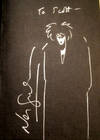

Aedium Farnesiarum Tabulae ab Annibale Caraccio AEdium Farnesiarum tabulae ab Annibale Caraccio depictae: a Carolo Caesio aeri insculptae, atque a Lucio Philarchaeo explicationibus illustratae
by CARRACCI (Annibale), and Michelangelo Monsagrati; Carlo Gesi:
- Used
- Hardcover
- first
- Condition
- See description
- Seller
-
LONDON, United Kingdom
Payment Methods Accepted
About This Item
Romae: Sumptibus Venantii Monaldini Bibliopolae in via Cursus, 1753. FIRST EDITION. Folio, 435 x 305 mms., 7 preliminary leaves, followed by lxxiv pages, with engraved frontispiece, title-page in red and black, and thirty-three engraved plates (15 folding), engraved tail-pieces, contemporary vellum; small paper flaw in one plate, but a fine copy of these superbly engraved plates. These engravings (by Carlo Cesi) of the frescoes in the Palazzo Farnese that Carracci (1560 - 1609) are the result of Carracci's being "recommended by the Duke of Parma, Ranuccio I Farnese, to his brother, the Cardinal Odoardo Farnese, who wished to decorate the piano nobile of the cavernous Roman Palazzo Farnese. In November–December of 1595, Annibale and Agostino traveled to Rome to begin decorating the Camerino with stories of Hercules, appropriate since the room housed the famous Greco-Roman antique sculpture of the hypermuscular Farnese Hercules. Annibale meanwhile developed hundreds of preparatory sketches for the major work, wherein he led a team painting frescoes on the ceiling of the grand salon with the secular quadri riportati of The Loves of the Gods, or as the biographer Giovanni Bellori described it, Human Love governed by Celestial Love. Although the ceiling is riotously rich in illusionistic elements, the narratives are framed in the restrained classicism of High Renaissance decoration, drawing inspiration from, yet more immediate and intimate, than Michelangelo's Sistine Ceiling as well as Raphael's Vatican Logge and Villa Farnesina frescoes. His work would later inspire the untrammelled stream of Baroque illusionism and energy that would emerge in the grand frescoes of Cortona, Lanfranco, and in later decades Andrea Pozzo and Gaulli.Throughout the 17th and 18th centuries, the Farnese Ceiling was considered the unrivaled masterpiece of fresco painting for its age. They were not only seen as a pattern book of heroic figure design, but also as a model of technical procedure; Annibale's hundreds of preparatory drawings for the ceiling became a fundamental step in composing any ambitious history painting" (Wikipedia). The tail-pieces of small children, one or two of which could be construed as rather naughty, are by Giacinto Gimignani (1611 - 1681). Leopoldo Cicognara: Catalogo ragionato dei libri d'arte e d'antichità posseduti dal Conte Cicognara (1821), 3376: "L'autore del testo pose grandissima cura a impinguarlo di erudizione, e l'editore v'aggiunse quantita d'altri rami, e vignette prese da altre opera, ma le 33 tavolo di Carlo Cesio sono in questa ristampa alquanto logore per quata sia fresco e nitido l'esemplare.
Reviews
(Log in or Create an Account first!)
Details
- Bookseller
- John Price Antiquarian Books
(GB)
- Bookseller's Inventory #
- 8223
- Title
- Aedium Farnesiarum Tabulae ab Annibale Caraccio AEdium Farnesiarum tabulae ab Annibale Caraccio depictae: a Carolo Caesio aeri insculptae, atque a Lucio Philarchaeo explicationibus illustratae
- Author
- CARRACCI (Annibale), and Michelangelo Monsagrati; Carlo Gesi:
- Book Condition
- Used
- Binding
- Hardcover
- Publisher
- Romae: Sumptibus Venantii Monaldini Bibliopolae in via Cursus, 1753
- Keywords
- illustration art prose
Terms of Sale
John Price Antiquarian Books
Payment by cheque, credit card, cash. New customers will be invoiced pro forma. Books may be returned within two weeks for any reason; refund within 1 month for any reason; negotiable after that, but no returns after one year.
About the Seller
John Price Antiquarian Books
Biblio member since 2006
LONDON
About John Price Antiquarian Books
I work from home, but I am happy to see customers at almost any time by appointment.
Glossary
Some terminology that may be used in this description includes:
- Leaves
- Very generally, "leaves" refers to the pages of a book, as in the common phrase, "loose-leaf pages." A leaf is a single sheet...
- Fine
- A book in fine condition exhibits no flaws. A fine condition book closely approaches As New condition, but may lack the...
- Folio
- A folio usually indicates a large book size of 15" in height or larger when used in the context of a book description. Further,...
- First Edition
- In book collecting, the first edition is the earliest published form of a book. A book may have more than one first edition in...
- Vignette
- A decorative design or illustration placed at the beginning or end of a ...
- Plate
- Full page illustration or photograph. Plates are printed separately from the text of the book, and bound in at production. I.e.,...


